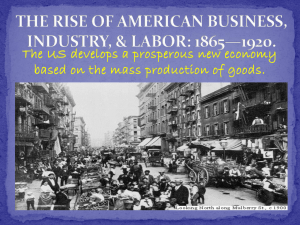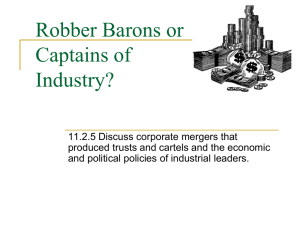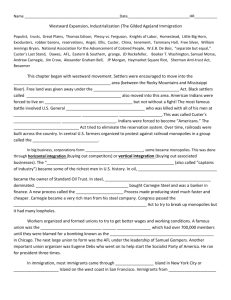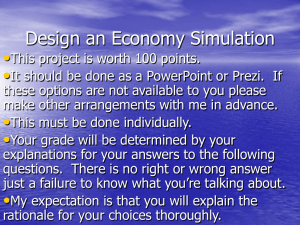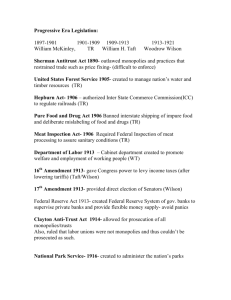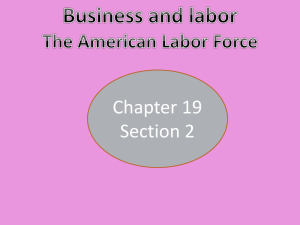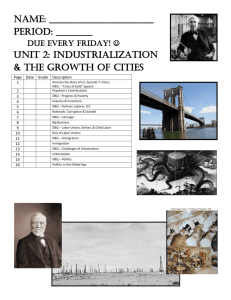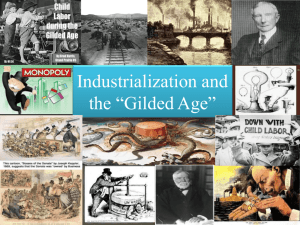Goal 5 Power Point
advertisement
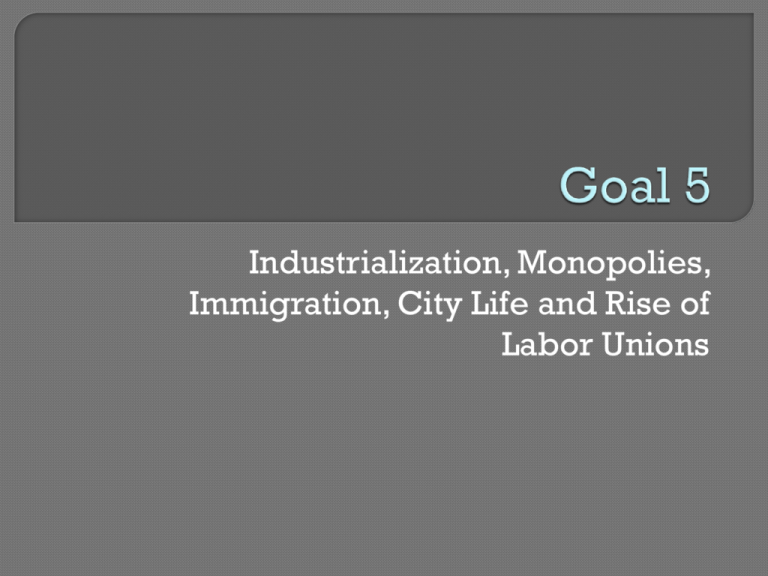
Industrialization, Monopolies, Immigration, City Life and Rise of Labor Unions Time period after Civil War • Made famous by author Mark Twain Time of rapid industrialization, immigration and changing city life Monopoly • Definition- when one business controls the entire industry • Two types of monopolies Vertical Integration- person controls all factors of production for one industry (used by Carnegie Steel) Horizontal Integration- person controls all competition in the same industry (used by Rockefeller Oil) Vertical Integration • When one company owns all factors of production and can charge lower prices • Example- Andrew Carnegie’s Steel Company Carnegie owned the iron mines, the shipping and the steel mills He could charge less because he didn’t have to pay the extra fees for using other companies Horizontal Integration • When one company completely controls an industry by buying all competition • Example- Rockefeller’s Oil Company Rockefeller would buy companies and give their owners stock in his company Trust- group of advisors for a company (control and set prices) John Rockefeller- Oil Andrew Carnegie- Steel Cornelius Vanderbilt- Railroads JP Morgan- banks Monopolies Price Fixing Eliminate Competition Unfair treatment of poor and middle class Captain of Industry • Owners praised for business skills and donating back to society (Carnegie) Robber Baron • Owners who became rich illegally or unethically and did not care about workers or society Theory used by rich to defend their wealth • Based on Charles Darwin’s theory on survival of the fittest • Rich said they deserved to be rich because they worked harder and were smarter than others Horatio Alger- wrote tales of underprivileged youths who became wealthy through being honest and hardworking SPAM- First Wave- 1820s to 1860s • Mainly from Northern and Western Europe • Scandinavia (Sweden, Norway), Ireland, Britain • Example- Many Irish will come due to Potato Famines Second Wave- 1890s to 1920s • Mainly from Southern and Eastern Europe • Italy, Russia, Hungary • Seen as different- most are Catholic or Orthodox religions, darker skinned, poorer classes • Many Jewish groups for religious freedom Melting Pot- immigrant groups give up their own ethnic identity and blend into one American identity Cultural Pluralism- immigrant groups keep parts of their own culture and also adopt parts of the American culture Nativism- groups that were antiimmigrant • Chinese Exclusion Act- banned Chinese laborers from immigrating to US until 1902 Melting Pot Theory Chinese Exclusion Act Cities grow tremendously • Known as urbanization (rapid growth of cities) Immigrants will settle in ethnic neighborhoods • Examples- Chinatowns, Little Italy, etc Most will live in tenement buildings • One room apartments • Overcrowded, dirty, no fire escapes, no plumbing, disease widespread, unsafe, unsanitary Jacob Riis • Write “How the Other Half Lives” • Expose living conditions in tenements in NYC Jane Addams • Begin Hull House in Chicago • Help poor immigrants learn English and other necessities (money, etc) Most immigrants work in sweatshops • Little pay, long hours, dangerous conditions Response • People band together to form labor unions Labor Unions • Fight for higher pay, better conditions and shorter hours • Most do not like immigrants because they work for low wages Labor Union- group of workers who want to improve economic and social well-being of its members • Craft Union- organizes workers in the same craft or occupation (Ex.- carpenters union, brickmasons union) • Trade Union- includes different kinds of workers (Ex- Union for all building tradeinclude painters, builders, carpenters, etc) Early Unions • Knights of Labor- organized in 1869 Will lose popularity after the Haymarket Strike • American Federation of Labor (AFL) Craft union organized by Samuel Gompers Later led by Eugene Debs Collective Bargaining- unions and management try to negotiate on an acceptable contract Strikes- workers stop working and try to shut down company • Scabs- during strike, company hire workers to cross strike lines and continue working • Injunction- court order to stop a strike Mediation- if collective bargaining fails, a 3rd party will be called to help settle differences • Each side (labor and management) state their case and the 3rd party gives recommendations • Not binding decision Arbitration- involves a 3rd party • Each side states their case and 3rd party makes decision • Decision made is binding and must be accepted Attempt to address monopolies • Sherman Anti-Trust Act- government outlaws trusts Not very effective Political machines and big city politics • Machine- one group who uses bribes and corruption to control government Ex- Boss Tweed and Tammany Hall in NYC Patronage- give government jobs based on political support (spoils system) • Pendleton Act- create a civil service system Civil Service System- government jobs given based on merit (usually by taking a civil service test) SPA- M-
